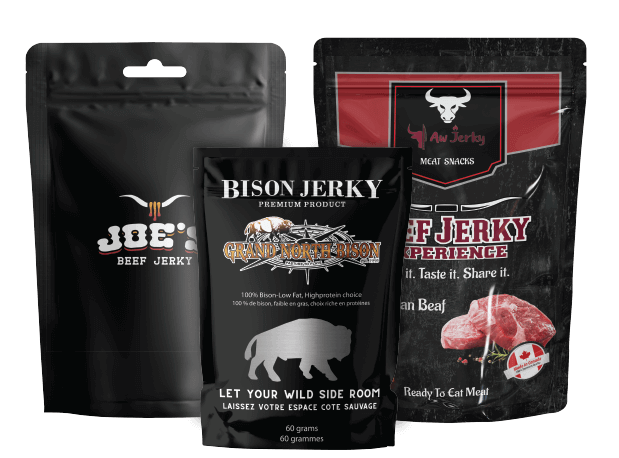
When To Package Beef Jerky
In the world of savoury snacks, few treats hold as much appeal and convenience as beef jerky.Knowing when to package beef jerky is crucial for ensuring its freshness and quality throughout its shelf life, typically occurring after the meat has been marinate, season, and dried to perfection. With its rich flavour, high protein content, and long shelf life, beef jerky has become a favourite go-to option for on-the-go snacking, outdoor adventures, and protein-packed indulgence. However, behind every satisfying bite of Beef Jerky Packaging lies a crucial component that often goes unnoticed but plays a pivotal role in maintaining its quality and freshness.
Post-Drying Preparation of Beef Jerky Packaging:
Once the beef has been carefully marinate, season, and dried to perfection, it’s time to prepare it for packaging. At this stage, the jerky should be cool to the touch and thoroughly dried to ensure optimal shelf life. Proper timing ensures that the jerky retains its flavour and texture during the packaging process.Allow the freshly dried beef jerky to cool completely before handling.Take time to inspect the jerky for consistency in texture and moisture content.Trim any excess fat or uneven edges from the jerky slices to improve presentation and ensure uniformity.
Minimising Exposure to Air:
Minimising exposure to air is essential in the packaging of beef jerky to preserve its freshness and prevent oxidation, which can lead to flavour degradation and spoilage. Once the jerky has been dry to perfection, packaging it promptly reduces the risk of moisture absorption and maintains its quality. Vacuum sealing or using oxygen absorbers removes excess air from the package, creating an airtight seal that prolongs shelf life. By reducing oxygen levels, oxygen absorbers help prevent the growth of mould and bacteria, ensuring the jerky remains safe for consumption.
Eye-catching Designs and Imagery:
Eye-catching designs and imagery play a crucial role in beef jerky packaging, as they aim to capture consumers’ attention and convey the product’s quality and appeal. Vibrant colours, engaging graphics, and high-quality product photography are use to create visually appealing packaging. Creative typography and unique patterns or textures further enhance the overall design, while consistent brand aesthetics help establish brand identity and recognition. Attention-grabbing shapes or layouts can also make the packaging stand out on store shelves, increasing the likelihood of attracting potential buyers.
Optimal Moisture Levels for Beef Jerky Packaging:
Optimal moisture levels are critical for packaging beef jerky to ensure its texture, flavour, and shelf life. Achieving the perfect balance of moisture is essential during the drying process, where excess moisture can lead to spoilage and insufficient moisture can result in tough, dry jerky. The jerky should feel firm and dry to the touch, yet retain some flexibility when bent without breaking. Visually, the surface should appear dry and matte, indicating that moisture has been adequately remove. When packaging, it’s crucial to select materials with moisture barrier properties to prevent moisture ingress or egress, maintaining the desired moisture levels.
Unique Patterns or Textures:
Unique patterns or textures in beef jerky packaging can add an extra dimension of visual interest and tactile appeal. Whether it’s a subtle emboss texture resembling wood grain or a bold pattern inspire by the outdoors, these elements can evoke the ruggedness and authenticity associate with jerky. Incorporating textures that mimic the meat’s texture or the environment where the meat was source can further enhance the connection between the packaging and the product. Additionally, these unique patterns or textures help differentiate the brand and make the packaging memorable to consumers browsing the shelves.
Preserving Seasonings and Flavours:
Preserving the seasonings and flavours of Beef Jerky Packaging is paramount in ensuring a delightful snacking experience for consumers. After the jerky has been carefully marinate and season, it’s crucial to maintain these flavours throughout the packaging process. Packaging the jerky promptly after drying helps seal in the savoury aromas and prevents the evaporation of volatile flavour compounds.
Using high-quality packaging materials with excellent barrier properties helps protect the jerky from exposure to light, moisture, and oxygen, which can degrade the flavours over time. Resealable pouches or containers allow consumers to enjoy the jerky over multiple sittings while keeping it fresh.
Protecting Against Contamination:
Protecting beef jerky against contamination is crucial to ensure its safety and maintain quality throughout its shelf life. Proper packaging techniques play a significant role in safeguarding the jerky from harmful microorganisms, moisture, and other environmental factors. Airtight packaging, such as vacuum-sealed bags or sealed pouches, creates a barrier that prevents contaminants from entering the package, reducing the risk of spoilage and foodborne illnesses. Additionally, packaging materials with antimicrobial properties can further inhibit the growth of bacteria and mould, enhancing the jerky’s shelf stability.
Antimicrobial Properties:
Selecting packaging materials with antimicrobial properties can further inhibit the growth of bacteria and mould, enhancing the jerky’s shelf stability and reducing the risk of contamination. These materials help extend the shelf life of the jerky while maintaining its quality and safety.Applying antimicrobial coatings or treatments to the surface of packaging materials can create a protective barrier against microbial contamination.Some packaging materials incorporate natural antimicrobial compounds derived from plant extracts, spices, or herbs.
Quality Control Measures:
Implementing stringent quality control measures throughout the production and packaging process is critical for identifying and preventing contamination risks. Regular inspections, microbial testing, and adherence to food safety standards help maintain the integrity of the jerky and ensure that it meets safety requirements.Conduct thorough inspections of incoming raw materials, including meat, seasonings, and packaging materials, to ensure they meet quality standards and specifications.
Conclusion:
In the dynamic world of beef jerky production, packaging plays a pivotal role in ensuring the preservation of freshness, flavour, and safety. From the moment the savoury meat is marinate, seasoned, and dried to perfection, to the final stage of sealing it within protective packaging, every step is carefully orchestrate to deliver a premium snacking experience.
By embracing innovative packaging technologies such as vacuum sealing, moisture barrier materials, and antimicrobial properties, producers can safeguard beef jerky against contamination and extend its shelf life without compromising its quality. For Custom Packaging Calgary, trust our expertise to tailor your packaging needs to perfection.
Recent Posts
Water Damage Extraction Guide
Electric Heater Fireplace Tips
Best Living Room Paint Colors
All Categories
- Apps
- Asian Games
- Auto
- Banking
- Beauty
- Blog
- Cricket
- Cricket
- Cryptocurrency
- Economy
- Education
- Fashion
- Fitness Zone
- Football News
- Gadgets
- Health
- Industry
- Interviews
- IPL
- Job & Feed
- Life Style
- Markets
- News
- News
- Other Sports News
- Restaurant
- Sports
- Stock Market News
- Tech News
- Technology
- Technology
- Top Stories
- Tours & Travel
- Travel
- Uncategorized
- World



